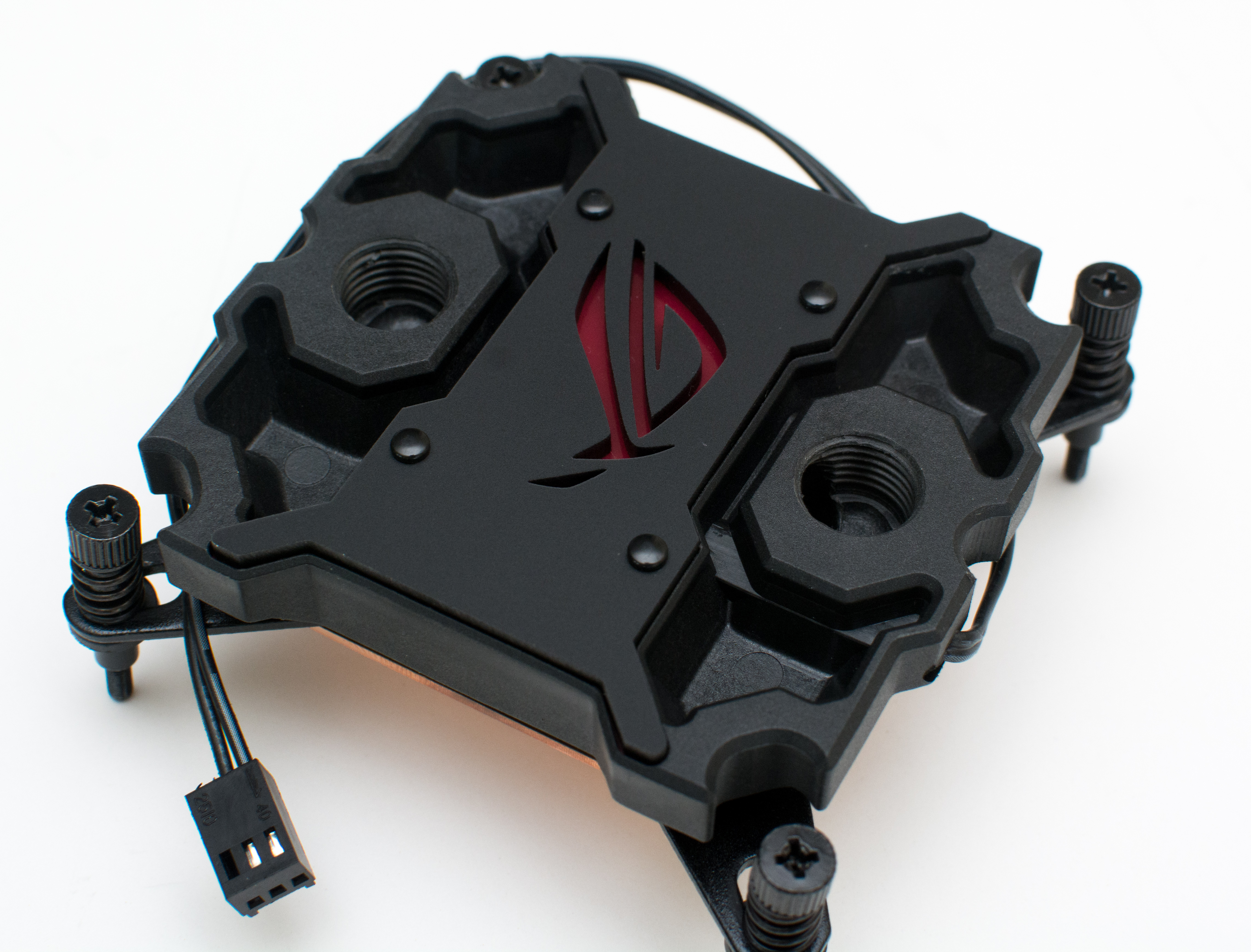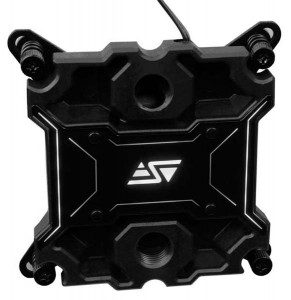Well that’s a long title for a review! So let’s clarify what the hell we are talking about. This is the Swiftech Apogee XL which is Swiftech’s latest CPU water block and replaces the older Apogee HD:
It comes with a built in LED and you can change the color by changing plastic “gels”. Performance PC’s then took this and modified it by replacing the Swiftech logo that sits in front of the LED with their own laser cut designs. For testing they sent their “ROG” edition:
Looks the same, but the sticky on the back gives it away:
Opening it up – you get color gels, backplates, mounts for AMD, and different thumbscrews for socket 2011:
Dat ROG logo:
Well you have to admit, it’s prettier than Swiftech’s. Some of the customized versions cover more of the block, we’d prefer that look to be honest, but this is still very pleasing. The block comes preattached to the backplate and needs no changes if you’re rocking socket 1150. If you’re running anything else you best get out a screwdriver and a circlip remove (or improvise with some flathead screwdrivers). The copper base is attached with a very safe 9 screws and a larger philips head means no easily stripped screws:
The cable is a three pin header that connects to a fan header on the motherboard and powers the LED. Only two wires are therefore used. It’s nice that it’s black plastic and black wire.
The 1150 backplate:
This backplate caused problems though it may not be Swiftech’s fault, but isntead Asus’s fault. The threaded part of the backplate is supposed to fit inside the PCB mounting hole and sit flush with the CPU side of the PCB. It does fit flush, but on the Maximus VI Impact the fit was so tight that I could not push it in by hand. Instead the block had to be placed and tightened down and this force pulled the backplate into place properly. The downside was that the shoulders on the thumbscrews wore the top of the PCB slightly. Swiftech say that they meet spec, and therefore it must be Asus that are out of spec. Without precise enough calipers I’m left to accept this is likely given how close Asus brings PCB traces to the holes.
Once powered up the LED gives the block a nice look that when combined with PPCs customization service could be used by modders to create some really cool designs!
The internals show a copper base made up of a pin matrix with two ports on either side. The symmetrical design of course makes this a bidirectional block. The purpose of the central o-ring is not strictly clear. The older Apogee HD block also had one. O-rings are normally only used to keep a seal on the coolant. Here it appears to be being used to insert a small bow to the block. O-rings are squishy however and will presumably age over time. It seems a bad choice to rely on an o-ring for bow vs a harder material like the block top, or an adjustable jetplate.
Of course looks are not everything, form follows function and the function is cooling.
Thermal Results
For thermal testing we did 5 mounts of each orientation using MX2 TIM which is better than most TIMs for curing effects and less sensitive to bow effects. The 4770K was overclocked and ran a meager 4.0GHz at 1.25V due to the thermal limitations of the 4770K. Prime95 with custom settings was used for loading on the CPU. A 1 hr loaded warmup/curing time was strictly enforced before data was logged for the next 30 minutes and compared to the coolant temperature. The average of all four cores over that 30 min period minus the coolant temperatures was used as the main performance metric.
The average of the five runs was then plotted vs other blocks. For an explanation of the rotation terms “regular/goofy” check this explanation.
As can be seen the best orientation of the Apogee XL is essentially the same as the older Apogee HD. We only tested one rotation of the Apogee HD because it is a diagonally symmetric block. While there will be slight performance differences in rotation, all four rotations must be tested and that’s just silly. For more details on the Apogee HD it was featured in the 2012 CPU block roundup.
In addition the XL is also behind the leading performance blocks from EK and Koolance. As we love to sanity check our results it seemed a good idea to vary flow to see if the XL improved at low flow given that it was designed to be part of an entry level (though high performance still) AIO cooling kit:
As can be seen the XL not only runs much lower flow rates, but it also favors lower flow becoming comparable to the 380 block. Given that the 380 block won the 2012 roundup this is good. Looking at the restriction we see just how much of a “low flow” block this is:
For an explanation on what that plot means check out our guide here.
Then to complete our thermal analysis we take a look at the standard deviation of the 5 mounts and use that to plot confidence intervals. In other words what range of temperatures are we 95% sure that any future runs would be within:
This gives an idea of the amount of error in testing, however it does not include variation from CPU to CPU and block to block. Sadly it’s impossible to get to a zero error even with unlimited time and resources to run multiple blocks and multiple cpus simply because there is variation over imperfect mounts and manufacturing variance on CPUs and blocks. However this plot at least gives a feel of the possible range of improvement you might see changing from block to block.
Summary
Overall the thermal performance of the block was decent, not exceptional but also not terrible. The restriction of the block, though an improvement over the HD, is still high. Given the performance I would say that restriction is unnecessarily high. The mounting system is still good – the use of thumbscrews with shoulders that can be turned with a philips head screwdriver and auto stop when tight enough makes life easy. I also like that since the HD the thumbscrews have shrunk and are now less noticeable. The input/output ports are also spaced further apart which helps if you want to use Swiftech’s QDC system. It’s obvious from the fact that this was designed primarily with the H220x AIO kit in mind that corners were cut in terms of performance and flow and that the focus was not on performance but on ease of use and price. Having said that though it’s still a very good block
The real innovation then is not the performance but the fact that this block has a built in LED and is easily moddable. Performance PC’s have created a new niche by allowing end users to order their block with their own custom design. We think that this makes the block a must buy then for anyone who wants a custom block and the performance loss is small enough to not be a concern. Initially I thought to give this a gold award because I really love the customization service PPCs does and the quality is great – but the fact is that we know that the underlying block is not as good as it could be, and even when seen in the light of a block for modders rather than performance enthusiasts it still falls short because of the underlying weaknesses of the Apogee XL. On the principle of saving gold awards for the “best there is” then the PPCs version therefore gets a silver award, while the regular Apogee XL does not.
Where to buy: PPCs of course
Video review:



























These low thermal performance and high pressure drop numbers do not appear to be representative of what we have seen in our own testing, as well as that of other third party independent reviewers with regards to the performance of our Apogee XL under similar tests. Due to this we suspect that the copper base may not have been re-installed correctly which would explain the high pressure drop and low thermal performance. We have contacted Simon a few days ago in this regard and are awaiting a response for clarification.
Stren,
I am considering ordering the block you tested. I was wondering, if you still have it, do you think adding some 1 or mm washers under the springs to increase pressure will improve performance based on the TIM pattern you got when unmounting it?
Also wondering what removing the center o ring (useless?) would do to performance? Any tests done real quickly by you without it?
Thanks!
Hey Rob
I haven’t tried either of those conditions. Poor TIM spread is usually caused by poor matching of the curvature (or bow) of the block to the inherent curvature or bow of the CPU. Increasing or decreasing pressure can sometimes help finetune bow matching but because it’s not the dominant factor can only do so much.
The bow you want entirely depends on what CPU you have. Larger CPU’s like socket 2011’s generally prefer small to zero amounts of bow, while small CPU’s like the 4790K prefer larger amounts of bow. If you have a 4790K I would think you want to increase the bow of the block by inserting something that will bow the base more than the o-ring does right now. So you could try various things, but honestly the difference will be small, and you might be likely to make it worse. If you want to try it, I would just learn to analyze your TIM spread and iterate until you get a good spread.
I am confused with the EK result.
what does the I1/j1 I1/j2 mean for the EK supremacy evo?
also what does the JP2 mean on EK supremacy?
EK blocks are reconfigurable depending on socket and tune their bow for the specific socket by using different jetplates and inserts. I1/I2 refers to the insert type as described in the EK instructions. J1/J2 refers to the jetplate number also. JP2 also refers to the jetplate number.
[…] H220x which is significantly cheaper at $140 vs EK’s $200. Swiftech use their Apogee XL CPU block alongside a very compact radiator where a ddc style pump and reservoir is mounted on one side. […]
where can you get gel plate and stencil options from. I bought a swiftech block and am looking for more color options than what came with it. (like the ROG option above)
Comments are closed.